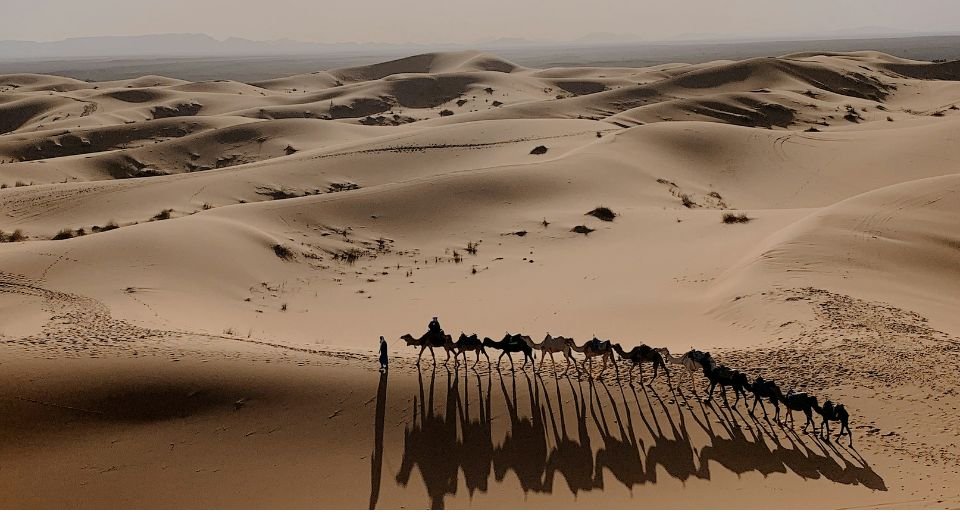Bharti Jayshankar
February 4, 2025: Climate change has emerged as a significant factor influencing weather patterns across the globe, particularly in arid regions such as the Sahara. Recent studies indicate that shifts in the intertropical convergence zone (ITCZ)—the equatorial area where winds from the northern and southern hemispheres converge—are causing unusual weather phenomena, including unseasonal rains in the Sahara.
Morocco’s southeastern desert witnessed rare rains in September 2024. Last year was Morocco’s driest in 80 years, with a 48 percent drop in rainfall, according to an October report from the General Directorate of Meteorology (DGM). But in September, torrential rains triggered floods in southern parts of Morocco, killing at least 28 people and in some parts arid valleys and dunes saw ancient lakes filling up.
According to Moroccan climate scientist Fatima Driouech, these changes may signal broader climate trends, although more comprehensive studies are necessary to definitively attribute such events to climate change.
However, desert floods aren’t tied solely to climate change. They are also influenced – and can be exacerbated – by natural oscillation patterns such as the Atlantic Multi-decadal Oscillation (AMO) and the Atlantic Zonal Mode (AZM).
These see long-term variations in sea surface temperatures, which alternate between warmer and cooler phases.
But the increasing frequency and intensity of extreme weather events, including storms and droughts, cannot be ignored, with experts warning that these patterns are becoming more pronounced.
Changed ecological dynamics
Moreover, the broader implications of climate change are reflected in changing ecological dynamics. The warming climate is altering species distributions and migration patterns, disrupting established ecosystems.
Invasive species can take advantage of these shifts, further threatening local biodiversity. Studies have shown that climate change may lead to yield losses for major cereal staples in regions like Sub-Saharan Africa, increasing food insecurity in areas already vulnerable to climate variability.
Additionally, recent climate modeling suggests that large-scale renewable energy projects, such as wind and solar installations in the Sahara and neighboring Sahel, could potentially increase local temperature and precipitation, fostering vegetation growth in these arid regions
This indicates that while climate change poses severe challenges, it also opens up discussions about potential adaptation strategies that could enhance the resilience of affected ecosystems.
Ecological implications
Unseasonal rains in the Sahara can offer temporary ecological benefits, such as enriching the soil and promoting the growth of plants that provide food for herbivores. This increase in plant life leads to a subsequent rise in herbivore populations, which, in turn, benefits predators in the food chain. However, these periods of abundance are typically short-lived, followed by a return to arid conditions that can challenge wildlife accustomed to rapid environmental changes.
Animals in the Sahara have also evolved various strategies to cope with the harsh conditions. Many exhibit physical adaptations, such as streamlined bodies and specialized limbs to navigate loose sand. Behavioral adaptations, including nocturnal habits to avoid daytime heat, reduce water loss and predator exposure.
A changing ecosystem will introduce different species of flora and fauna and animals, disturbing the established cycles of survival that have developed over innumerable years of evolution.
Human impact and conservation challenges
Human activities, such as habitat destruction and overgrazing, pose significant threats to the Sahara’s ecology. Urban development, agriculture, and deforestation have led to habitat loss, further exacerbating the natural challenges faced by desert biodiversity.
Community engagement in conservation efforts can promote sustainable practices and foster a sense of ownership over local resources.
Historical climate events and human migration
Research into historical climate events, particularly during the Green Sahara periods, demonstrates the profound impact of climatic changes on human migration patterns. For instance, the well-constrained chronology of environmental changes in Northwest Africa has been linked to the migration of Anatomically Modern Humans (AMH) out of Africa.
The study revealed that the Green Sahara not only influenced the ecology of the region but also played a critical role in shaping human dispersal and cultural advancements during periods of climatic fluctuation.
The impacts of climate change on agricultural productivity are particularly acute in sub-Saharan Africa, where much of the food production relies on rain-fed systems. Erratic rainfall and rising temperatures threaten to undermine food availability and security, particularly for vulnerable populations
Recent studies indicate that sub-Saharan Africa is projected to experience significant yield losses for major cereal staples due to climate change, compounding issues of food insecurity that have already reached alarming levels in the region
Food insecurity levels in sub-Saharan Africa are now more than twice the global average, with Central and East Africa facing the most severe challenges.
“Deserts are much more complex than most people realise. Any stress will lead to rapid breakdown in the ecosystem,” says Prof Paul Carling, Emeritus Professor in physical geography at the University of Southampton.
“These soils are fragile and readily disturbed. Climatic instability and human pressures on these areas, including poorly designed flood protection infrastructure, can rapidly lead to degradation.”
Future projections
Future projections regarding precipitation patterns in the Sahara region indicate significant changes that could impact the area’s ecology and human populations. Recent climate models, suggest an increase in rainfall for traditionally arid regions, including parts of the Sahel and Sahara, contrary to historical trends of diminishing rainfall in these areas.
It is projected that the capacity of warmer air to hold moisture will lead to more intense rainfall occurrences, potentially increasing the frequency of extreme weather events
The interplay between climate change, ecological disruption, and human livelihoods underscores the urgent need for effective adaptation strategies and sustainable resource management in the region. In light of these developments, researchers emphasize the importance of monitoring ecological dynamics and developing comprehensive cl
